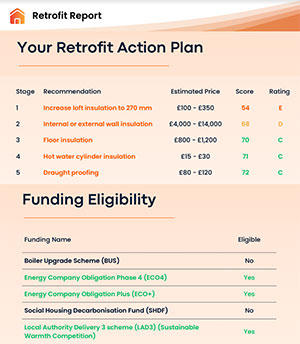Online EPC Check and Energy Retrofit Reports

Are you in the process of buying or renting a property in the UK and need an online EPC check? Or are you a landlord who needs to view the energy efficiency of your properties? PropertyData's Plot Map tool is an easy way to perform an online EPC check.
What is an EPC?
An Energy Performance Certificate (EPC) is a document that outlines the energy efficiency of a property. It provides a rating from A to G, with A being the most energy efficient and G being the least. EPCs are required for all properties built, sold, or rented in the UK.
Why is an EPC important?
Having an EPC is crucial for property buyers, renters, and landlords. For buyers and renters, an EPC can help them understand a property's energy efficiency, which can impact the cost of utilities and overall living expenses. An EPC is a legal requirement for landlords, and failure to comply can result in fines and penalties.
What are the current EPC rules for landlords?
Currently all properties that are let to tenants require an EPC rating of ‘E’ or above. It is illegal to let a property with and F or G rating.
From 2025, all newly rented properties will be required to have an EPC rating of C or above. For existing tenancies, the new regulations won’t apply until 2028.

How can PropertyData's Plot Map help with an Online EPC Check?
PropertyData's Plot Map tool is a user-friendly and efficient way to perform an online EPC check for any property in the UK.
Perform an Online EPC Check with PropertyData's Plot Map
Enter the property's address or postcode, and the tool will provide an instant EPC report outlining the property's energy efficiency rating.
Access to Energy Retrofit Reports

In addition, PropertyData's Plot Map tool also provides access to Energy Retrofit Reports, which outline recommended steps for improving a property's energy efficiency. This can be particularly helpful for landlords who want to improve the energy efficiency of their properties to comply with the upcoming changes to EPC regulations in 2023.
Performing an online EPC check with PropertyData's Plot Map tool is an easy and efficient way to ensure that you comply with EPC regulations and better understand the energy efficiency of any property in the UK. Try it today and make informed decisions about your property investments.
Why Use PropertyData for your Online EPC Check?
Whether you're a property investor, developer, or agent, PropertyData can help you make better-informed decisions and gain an edge over the competition. We designed our tools for anyone involved in the UK property market, from investors to landlords to estate agents. Here are some of the benefits of using PropertyData:
-
Comprehensive Property Data
PropertyData provides comprehensive data on millions of properties across the UK, including historical sale and rental data, ownership information, and more. This data can be invaluable for making informed decisions about property investments and sales.
-
User-Friendly Interface
PropertyData's user-friendly interface makes searching for and accessing property data accessible. The intuitive design and powerful search functions ensure that you can find the data you need quickly and easily.
-
Up-to-Date Information
PropertyData is updated in real-time. You can be confident you're working with the most accurate and up-to-date property information.
-
Competitive Pricing
We offer competitive pricing plans designed to meet the needs of businesses and individuals of all sizes.



